#Matilda of Saxony
Text

Matilda, Eleanor, and Joanna - retrospring request for the Angevin daughters
#Angevin empire#Plantagenets#Matilda of Saxony#Eleanor of England queen of Castile#Joanna of Sicily#12th century#medieval#medieval women#requests#my art
124 notes
·
View notes
Text
“It was perhaps appropriate, as a memorial to his mother, that the year after the empress’s death Henry sent his eldest daughter, Matilda, to be married to Henry the Lion, duke of Saxony and Bavaria, thereby preserving the links between the English Crown and the German states.
But with four brothers, this Matilda was not likely to be recalled from Germany to fight for England. In Henry II’s plans, that honor belonged to his eldest son and namesake. In 1162, and 1163 young Henry had already received the homage of the English barons, the Scottish king, and the prince of Wales.
His father’s plan to have him crowned rex designatus had stalled thanks to the quarrel with Becket, because only the archbishop of Canterbury could crown an English king. Nevertheless, King Henry made it clear that he wished the boy to grow up to rule over the entire Plantagenet patrimony: England, Normandy, and Anjou.”
— Dan Jones, The Plantagenets. The Warrior Kings and Queens Who Made England
#henry ii#henry the young king#author: dan jones#in honour of dan being a petty mean girl & bullying ricardians on twt today x#thanks 👑#matilda of saxony
1 note
·
View note
Text
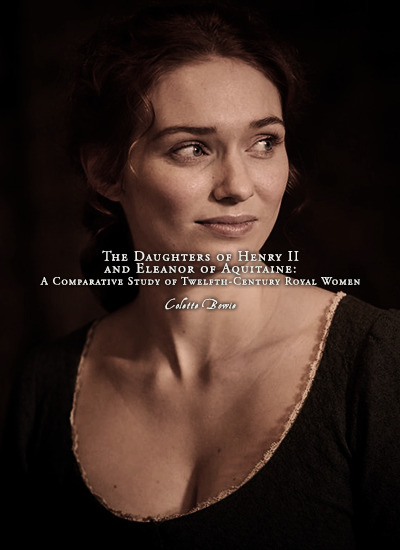


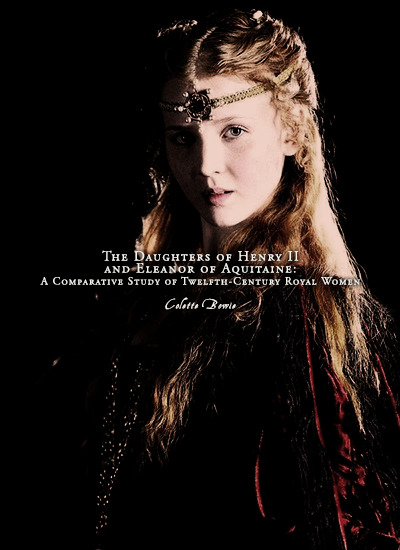


Favorite History Books || The Daughters of Henry II and Eleanor of Aquitaine: A Comparative Study of Twelfth-Century Royal Women by Colette Bowie ★★★★☆
This study compares and contrasts the experiences of the three daughters of Henry II and Eleanor of Aquitaine. The exogamous marriages of Matilda, Leonor, and Joanna, which created dynastic links between the Angevin realm and Saxony, Castile, Sicily and Toulouse, served to further the political and diplomatic ambitions of their parents and spouses. It might be expected that their choices in religious patronage and dynastic commemoration would follow the customs and patterns of their marital families, yet the patronage and commemorative programmes of Matilda, Leonor, and Joanna provide evidence of possible influence from their natal family which suggests a coherent sense of family consciousness.
To discern why this might be the case, an examination of the childhoods of these women has been undertaken (Part I), to establish what emotional ties to their natal family may have been formed at this impressionable time. In Part II, the political motivations for their marriages are analysed, demonstrating the importance of these dynastic alliances, as well as highlighting cultural differences and similarities between the courts of Saxony, Castile, Sicily, and the Angevin realm. Dowry and dower portions (Part III) are important indicators of the power and strength of both their natal and marital families, and give an idea of the access to economic resources which could provide financial means for patronage. Having established possible emotional ties to their natal family, and the actual material resources at their disposal, the book moves on to an examination of the patronage and dynastic commemorations of Matilda, Leonor and Joanna (Parts IV-V), in order to discern patterns or parallels. Their possible involvement in the burgeoning cult of Thomas Becket, their patronage of Fontevrault Abbey, the names they gave to their children, and finally the ways in which they and their immediate families were buried, suggest that all three women were, to varying degrees, able to transplant Angevin family customs to their marital lands. The resulting study, the first of its kind to consider these women in an intergenerational dynastic context, advances the hypothesis that there may have been stronger emotional ties within the Angevin family than has previously been allowed for.
#historyedit#history books#litedit#house of plantagenet#english history#medieval#french history#european history#women's history#history#nanshe's graphics
54 notes
·
View notes
Text
Wives and Daughters of Holy Roman Emperors: Age at First Marriage
I have only included women whose birth dates and dates of marriage are known within at least 1-2 years, therefore, this is not a comprehensive list.
This list does not include women who died before their husbands were crowned Emperor. It spans between the beginning of the reign of Otto I (962 CE) and the end of the reign of Francis II (1806 CE).
The average age at first marriage among these women was 17. The sample size was 91 women. The youngest bride, Bianca Maria Sforza, was just 2 years old when she wed her first husband, who was himself 9. The oldest bride, Constance of Sicily, was 32 years old.
Adelaide of Italy, wife of Otto I, HRE: age 15 when she married Lothair II, King of Italy, in 947 CE
Liutgarde of Saxony, daughter of Otto I, HRE: age 15 when she married Conrad the Red, Duke of Lorraine, in 947 CE
Theophanu, wife of Otto II, HRE: age 17 when she married Otto in 972 CE
Cunigunde of Luxembourg, wife of Henry II, HRE: age 24 when she married Henry in 999 CE
Gisela of Swabia, wife of Conrad II, HRE: age 12 when she married Brun I of Brunswick in 1002 CE
Agnes of Poitou, wife of Henry III, HRE: age 18 when she married Henry in 1043 CE
Matilda of Germany, daughter of Henry III, HRE: age 11 when she married Rudolf of Rheinfelden in 1059 CE
Judith of Swabia, daughter of Henry III, HRE: age 9 when she married Solomon, King of Hungary in 1063 CE
Bertha of Savoy, wife of Henry IV, HRE: age 15 when she married Henry in 1066 CE
Agnes of Waiblingen, daughter of Henry IV, HRE: age 14 when she married Frederick I, Duke of Swabia in 1086 CE
Empress Matilda, wife of Henry V, HRE: age 12 when she married Henry in 1114 CE
Beatrice I, Countess of Burgundy, wife of Frederick I, HRE: age 13 when she married Frederick in 1156 CE
Beatrice, daughter of Frederick I, HRE: age 10 when she married Guillaume II, Count of Chalon in 1173 CE
Constance, Queen of Sicily, wife of Henry IV, HRE: age 32 when she married Henry IV in 1186 CE
Beatrice of Swabia, first wife of Otto IV, HRE: age 14 when she married Otto in 1212 CE
Maria of Brabant, second wife of Otto IV, HRE: age 24 when she married Otto in 1214 CE
Constance of Aragon, first wife of Frederick II, HRE: age 19 when she married Emeric of Hungary in 1198 CE
Isabella II of Jerusalem, second wife of Frederick II, HRE: age 13 when she married Frederick in 1225 CE
Isabella of England, third wife of Frederick II, HRE: age 21 when she married Frederick in 1235 CE
Margaret of Sicily, daughter of Frederick II, HRE: age 14 when she married Albert II, Margrave of Meissen in 1255 CE
Anna of Hohenstaufen, daughter of Frederick II, HRE: age 14 when she married John III Doukas Vatatzes in 1244 CE
Marie of Luxembourg, daughter of Henry VII, HRE: age 18 when she married Charles IV of France in 1322 CE
Beatrice of Luxembourg, daughter of Henry VII, HRE: age 13 when she married Charles I of Hungary in 1318 CE
Margaret II, Countess of Hainaut, wife of Louis IV, HRE: age 13 when she married Louis in 1324 CE
Matilda of Bavaria, daughter of Louis IV, HRE: age 10 when she married Frederick II, Margrave of Meissen in 1323 CE
Beatrice of Bavaria, daughter of Louis IV, HRE: age 12 when she married Eric XII of Sweden in 1356 CE
Anna von Schweidnitz, wife of Charles IV, HRE: age 14 when she married Charles in 1353 CE
Elizabeth of Pomerania, wife of Charles IV, HRE: age 16 when she married Charles in 1378 CE
Margaret of Bohemia, daughter of Charles IV, HRE: age 7 when she married Louis I of Hungary in 1342 CE
Catherine of Bohemia, daughter of Charles IV, HRE: age 14 when she married Rudolf IV, Duke of Austria in 1356 CE
Elisabeth of Bohemia, daughter of Charles IV, HRE: age 8 when she married Albert III, Duke of Austria in 1366 CE
Anne of Bohemia, daughter of Charles IV, HRE: age 16 when she married Richard II of England in 1382 CE
Margaret of Bohemia, daughter of Charles IV, HRE: age 8 when she married John III, Burgrave of Nuremburg in 1381 CE
Barbara of Cilli, wife of Sigismund, HRE: age 13 when she married Sigismund in 1405 CE
Elizabeth of Luxembourg, daughter of Sigismund, HRE: age 13 when she married Albert II of Germany in 1422 CE
Eleanor of Portugal, wife of Frederick III, HRE: age 18 when she married Frederick in 1452 CE
Kunigunde of Austria, daughter of Frederick III, HRE: age 22 when she married Albert IV, Duke of Bavaria in 1487 CE
Bianca Maria Sforza, wife of Maximilian I, HRE: age 2 when she married Philibert I, Duke of Savoy in 1474 CE
Margaret of Austria, daughter of Maximilian I, HRE: age 17 when she married John, Prince of Asturias in 1497 CE
Barbara von Rattal, daughter of Maximilian I, HRE: age 15 when she married Siegmund von Dietrichstein in 1515 CE
Dorothea of Austria, daughter of Maximilian I, HRE: age 22 when she married Johan I of East Frisia in 1538 CE
Isabella of Portugal, wife of Charles V, HRE: age 23 when she married Charles in 1526 CE
Maria of Austria, daughter of Charles V, HRE: age 20 when she married Maximilian II, HRE in 1548 CE
Joanna of Austria, daughter of Charles V, HRE: age 17 when she married John Manuel, Prince of Portugal in 1552 CE
Margaret of Parma, daughter of Charles V, HRE: age 14 when she married Alessandro de’ Medici, Duke of Florence, in 1536 CE
Elizabeth of Austria, daughter of Ferdinand I, HRE: age 16 when she married Sigismund II Augustus of Poland in 1543 CE
Anna of Austria, daughter of Ferdinand I, HRE: age 17 when she married Albert V, Duke of Bavaria in 1546 CE
Maria of Austria, daughter of Ferdinand I, HRE: age 15 when she married William of Julich-Cleves-Berg in 1546 CE
Catherine of Austria, daughter of Ferdinand I, HRE: age 16 when she married Francesco III Gonzaga in 1559 CE
Eleanor of Austria, daughter of Ferdinand I, HRE: age 27 when she married William I, Duke of Mantua in 1561 CE
Barbara of Austria, daughter of Ferdinand I, HRE: age 26 when she married Alfonso II d’Este in 1565 CE
Joanna of Austria, daughter of Ferdinand I, HRE: age 18 when she married Francesco I de’ Medici in 1565 CE
Anna of Austria, daughter of Maximilian II, HRE: age 21 when she married Philip II of Spain in 1570 CE
Elisabeth of Austria, daughter of Maximilian II, HRE: age 16 when she married Charles IX of France in 1570 CE
Anna of Tyrol, wife of Matthias, HRE: age 26 when she married Matthias in 1611 CE
Eleonora Gonzaga the Elder, wife of Ferdinand II, HRE: age 24 when she married Ferdinand in 1622 CE
Maria Anna of Austria, daughter of Ferdinand II, HRE: age 25 when she married Maximilian I, Elector of Bavaria in 1635 CE
Cecilia Renata of Austria, daughter of Ferdinand II, HRE: age 26 when she married Władysław IV of Poland in 1637 CE
Maria Anna of Spain, wife of Ferdinand III, HRE: age 25 when she married Ferdinand in 1631 CE
Maria Leopoldine of Austria, wife of Ferdinand III, HRE: age 16 when she married Ferdinand in 1648 CE
Eleonora Gonzaga the Younger, wife of Ferdinand III, HRE: age 21 when she married Ferdinand in 1651 CE
Mariana of Austria, daughter of Ferdinand III, HRE: age 15 when she married Philip IV of Spain in 1649 CE
Eleonore of Austria, daughter of Ferdinand III, HRE: age 17 when she married Michael I of Poland in 1670 CE
Maria Anna Josepha of Austria, daughter of Ferdinand III, HRE: age 24 when she married Johann Wilhelm II, Elector Palatine in 1678 CE
Margaret Theresa of Spain, wife of Leopold I, HRE: age 15 when she married Leopold in 1666 CE
Claudia Felicitas of Spain, wife of Leopold I, HRE: age 20 when she married Leopold in 1673 CE
Eleonore Magdalene of Neuberg, wife of Leopold I, HRE: age 21 when she married Leopold in 1676 CE
Maria Antonia of Austria, daughter of Leopold I, HRE: age 16 when she married Maximilian II Emanuel, Elector of Bavaria in 1685 CE
Maria Anna of Austria, daughter of Leopold I, HRE: age 25 when she married John V of Portugal in 1708 CE
Wilhelmine Amalie of Brunswick, wife of Joseph I, HRE: age 26 when she married Joseph in 1699 CE
Maria Josepha of Austria, daughter of Joseph I, HRE: age 20 when she married Augustus III of Poland in 1719 CE
Maria Amalia of Austria, daughter of Joseph I, HRE: age 21 when she married Charles VII, HRE in 1722 CE
Elisabeth Christine of Brunswick, wife of Charles VI, HRE: age 17 when she married Charles in 1708 CE
Maria Theresa of Austria, daughter of Charles VI, HRE: age 19 when she married Francis I, HRE in 1736 CE
Maria Anna of Austria, daughter of Charles VI, HRE: age 26 when she married Charles Alexander of Lorraine in 1744 CE
Maria Antonia of Bavaria, daughter of Charles VII, HRE: age 23 when she married Frederick Christian, Elector of Saxony in 1747 CE
Maria Anna Josepha of Bavaria, daughter of Charles VII, HRE: age 20 when she married Louis George of Baden-Baden in 1755 CE
Maria Josepha of Bavaria, daughter of Charles VII, HRE: age 26 when she married Joseph II, HRE in 1765 CE
Maria Christina, daughter of Francis I, HRE: age 24 when she married Albert Casimir, Duke of Teschen in 1766 CE
Maria Amalia, daughter of Francis I, HRE: age 23 when she married Ferdinand I, Duke of Parma in 1769 CE
Maria Carolina, daughter of Francis I, HRE: age 16 when she married Ferdinand IV & III of Sicily in 1768 CE
Maria Antonia, daughter of Francis I, HRE: age 14 when she married Louis XVI of France in 1770 CE
Maria Josepha of Bavaria, wife of Joseph II, HRE: age 26 when she married Joseph in 1765 CE
Maria Luisa of Spain, wife of Leopold II, HRE: age 19 when she married Leopold in 1764 CE
Maria Theresa of Austria, daughter of Leopold II, HRE: age 20 when she married Anthony of Saxony in 1787 CE
Maria Clementina of Austria, daughter of Leopold II, HRE: age 20 when she married Francis I of Sicily in 1797 CE
Maria Theresa of Naples, wife of Francis II, HRE: age 18 when she married Francis in 1790 CE
Marie Louise, daughter of Francis II, HRE: age 19 when she married Napoleon I of France in 1810 CE
Maria Leopoldina, daughter of Francis II, HRE: age 20 when she married Pedro I of Brazil and IV of Portugal in 1817 CE
Clementina, daughter of Francis II, HRE: age 18 when she married Leopold of Salerno in 1816 CE
Marie Caroline, daughter of Francis II, HRE: age 18 when she married Frederick Augustus of Saxony in 1819 CE
34 notes
·
View notes
Text
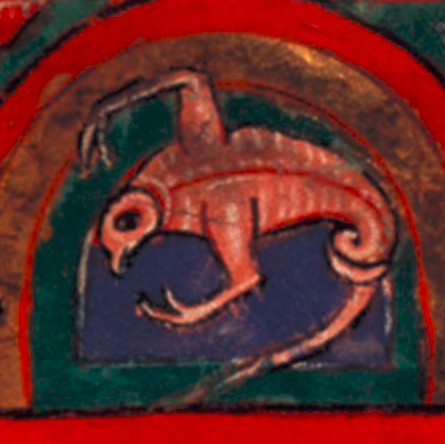
Welcome to another Scorpion Sunday! This one is from the "Psalter of Henry the Lion". The British Library lists it as having been commissioned by the aforementioned Henry the Lion, duke of Saxony and Bavaria, and produced by the monk Heriman of Helmarshausen sometime between 1168 and 1189.
Side note about Henry the Lion, for people like me who know medieval English history better than medieval German history: Henry's wife was Matilda of England, daughter of the famous Eleanor of Aquitaine. This Matilda is not to be confused with the Empress Matilda who led one side of the bloody English civil war known as the Anarchy -- that would be her paternal grandmother and namesake. (I know this because I googled "Henry the Lion", saw he was married to "Matilda of England", and thought, "ooh, is she that Matilda?" No, but she's named after her.)
You can see from the picture that the scorpion is in some sort of arch-shaped frame -- that's because this is from a calendar page. (Which is why we know that this is a scorpion -- it's the Zodiac animal for the month.) It's actually a pretty fancy calendar, gold lettering on colored parchment. Looks like this:
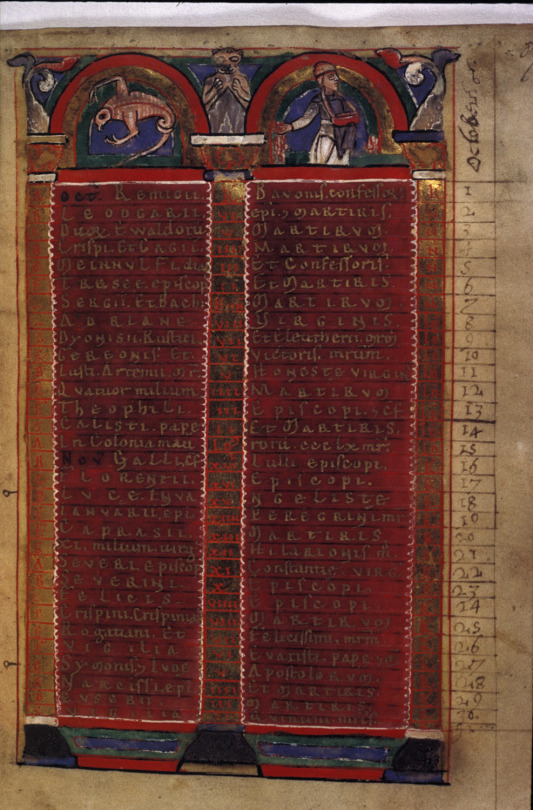
That's some expensive stuff. Spoiled by the look of that scorpion, though, so let's get back to it.
Note the twisty tail on this scorpion -- this might be another example of people misinterpreting Pliny the Elder's description and trying to draw a knotted tail. It's an off-putting shade of pink, which might be an artifact of the dyed parchment, but has an unpleasant aesthetic effect. It also doesn't have legs, so I can't give it full points for being a small scuttling beaſtie, but since I gave the last one with just claws half-credit, a precedent has been set.
Points:
Small Scuttling Beaſtie? ½
Pincers? ✔
Exoskeleton or Shell? ✘
Visible Stinger? ✘
Limbs? 2
The vibes are bad. The pink color, the long tail, and the big eyes make this thing look like a fetus or embryo of some sort. This is not a completed animal. I thought about giving it a straight zero, but it's not so much a nightmare-beast as just... pathetic and gross. I feel bad describing an animal that way, but it's not real, so whatever. 1/5.
Total score:
2.7 / 10
Ew.
---
Side note, this artist doesn't know what a crab is either:
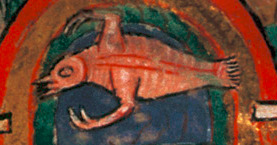
I was going to question how that happened -- sure, this is from central Germany, so not exactly coastal, but surely you have crabs? However, a quick Google indicates that the only freshwater crab species in Germany is an invasive species accidentally introduced from Asia in the early 20th century. So... okay. Maybe our man Heriman of Helmarshausen didn't travel much and had never seen a crab. Which is why he's drawn a fish with claws and a spiky face.
28 notes
·
View notes
Note
What sort of dowry, if they did it, do you think a princess like Myrcella would be given in asoiaf? If it helps I was looking at real life history and King johns daughter Eleanor Plantagenet had a dowry of 10 manors and 200 pounds per year for a marriage to an Earl in 1200’s. Catherine of Aragon had a 200,000-ducat dowry in early 1500’s to marry a king. King Henry 2nds daughter Matilda of England, Duchess of Saxony had £4500 for a dowry in late 1100’s. But how would that translate to asoiaf?
I don’t think it requires much translation. It’s much the same. We know of “contemporary” dowries in Westeros, and they consist of lands, gifts, and/or money. Walda is chosen amongst the other Frey girls because Walder Frey promised the bride’s weight in silver as a dowry, for example. Jaime tells Edmure if his wife’s baby is a girl, the Lannisters will give her a good dowry, which I could imagine being Lannister gold. Um, if we go back to a pre-conquest princess, Princess Argella Durrandon was supposed to come with a dowry of all lands east of the God’s Eye as her dowry. Chunks of land, coin.
8 notes
·
View notes
Text
Where John established chaplains and made gifts for the souls of his brothers Henry the Young King and Richard, similar arrangements for Geoffrey were almost non-existent. They appear to be limited to his inclusion amongst the royal relatives for whom chaplains were to pray at Lichfield, arrangements made not by John but by Bishop Geoffrey Muschamp in 1206. There may have been good reason for this lack of attention. Those for whom John made provision were anointed kings and queens who died within the Angevin lands. Geoffrey died in Paris. John does not seem to have provided for the souls of his sisters Matilda, who died in Saxony (1189), and Eleanor, who died in Castile (1214). Yet John could hardly have known these sisters, who left the Angevin lands in 1167 and 1170. He did know Geoffrey, whose final rebellion, unlike that of the Young King, was not in alliance with his brothers. His death was also to John’s advantage, increasing his chances of becoming king. John was in direct competition with the duke of Brittany’s son Arthur for the succession. He may have preferred not to commemorate Geoffrey.
This trend is further confirmed by naming patterns. In naming his legitimate children, John largely followed the example of his own parents, except that Geoffrey, a traditional Angevin name, was absent, as were two names with Anglo-Norman, Angevin, and (or) Aquitainian pedigree: William and Matilda.
-Paul Webster, King John and Religion
#''Arthur had been John's albatross and he knew it'' etc#''we are not looking. we do not see it'' asdfgg#thirteenth century#king john#Duke Geoffrey#prince arthur
6 notes
·
View notes
Note
Hi, Duchess! I was wondering if you knew of any German royals who married French ones?
Marie Antoinette & Louis XVI, Philippe duc d'Orleans & Elizabeth Charlotte, Princess Palatine, Gerberga of Saxony & Louis IV, Matilda of Frisia & Henri I, Isabeau of Bavaria & Charles VI, Elizabeth of Austria and Charles IX, Marie Louise of of Austria and Napoleon
5 notes
·
View notes
Text
SAINT OF THE DAY (March 14)

Matilda (also known as Matilda of Ringelheim), Queen of Germany and wife of King Henry I, was the daughter of Count Dietrich of Westphalia and Reinhild of Denmark.
She was born around 895 and was raised by her grandmother, the Abbess of Eufurt convent.
Matilda married Henry the Fowler, son of Duke Otto of Saxony, in the year 909.
He succeeded his father as Duke in the year 912. In 919, he succeeded King Conrad I to the German throne.
She was widowed in the year 936 and supported her son Henry's claim to his father's throne.
When her son Otto (the Great) was elected, she persuaded him to name Henry as Duke of Bavaria after he led an unsuccessful revolt.
St. Matilda was known for her considerable almsgiving. She was severely criticized by both Otto and Henry for what they considered as her extravagant gifts to charities.
As a result, she resigned her inheritance to her sons and retired to her country home.
She was later recalled to the court through the intercession of Otto's wife, Edith.
Matilda was welcomed back to the palace and her sons asked for her forgiveness.
In her final years, she devoted herself to the building of many churches, convents and monasteries.
She spent most of the declining years of her life at the convent she had built in Nordhausen.
She died at the monastery at Quedlinburg on 14 March 968 and was buried there with her late husband, Henry.
Matilda's two hagiographical biographies and The Deeds of the Saxons serve as authoritative sources about her life and work.
5 notes
·
View notes
Text
Events 2.2 (before 1920)
506 – Alaric II, eighth king of the Visigoths, promulgates the Breviary of Alaric (Breviarium Alaricianum or Lex Romana Visigothorum), a collection of "Roman law".
880 – Battle of Lüneburg Heath: King Louis III of France is defeated by the Norse Great Heathen Army at Lüneburg Heath in Saxony.
962 – Translatio imperii: Pope John XII crowns Otto I, Holy Roman Emperor, the first Holy Roman Emperor in nearly 40 years.
1032 – Conrad II, Holy Roman Emperor becomes king of Burgundy.
1141 – The Battle of Lincoln, at which Stephen, King of England is defeated and captured by the allies of Empress Matilda.
1207 – Terra Mariana, eventually comprising present-day Latvia and Estonia, is established.
1428 – An intense earthquake struck the Principality of Catalonia, with the epicenter near Camprodon. Widespread destruction and heavy casualties reported.
1438 – Nine leaders of the Transylvanian peasant revolt are executed at Torda.
1461 – Wars of the Roses: The Battle of Mortimer's Cross results in the death of Owen Tudor.
1536 – Spaniard Pedro de Mendoza founds Buenos Aires, Argentina.
1645 – Scotland in the Wars of the Three Kingdoms: Battle of Inverlochy.
1653 – New Amsterdam (later renamed The City of New York) is incorporated.
1709 – Alexander Selkirk is rescued after being shipwrecked on a desert island, inspiring Daniel Defoe's adventure book Robinson Crusoe.
1814 – The last of the River Thames frost fairs comes to an end.
1848 – Mexican–American War: The Treaty of Guadalupe Hidalgo is signed.
1850 – Brigham Young declares war on Timpanogos in the Battle at Fort Utah.
1868 – Pro-Imperial forces capture Osaka Castle from the Tokugawa shogunate and burn it to the ground.
1870 – The Seven Brothers (Seitsemän veljestä), a novel by Finnish author Aleksis Kivi, is published first time in several thin booklets.
1876 – The National League of Professional Baseball Clubs of Major League Baseball is formed.
1881 – The sentences of the trial of the warlocks of Chiloé are imparted.
1887 – In Punxsutawney, Pennsylvania, the first Groundhog Day is observed.
1899 – The Australian Premiers' Conference held in Melbourne decides to locate Australia's capital city, Canberra, between Sydney and Melbourne.
1900 – Boston, Detroit, Milwaukee, Baltimore, Chicago and St. Louis, agree to form baseball's American League.
1901 – Funeral of Queen Victoria.
1909 – The Paris Film Congress opens, an attempt by European producers to form an equivalent to the MPCC cartel in the United States.
1913 – Grand Central Terminal opens in New York City.
1 note
·
View note
Text
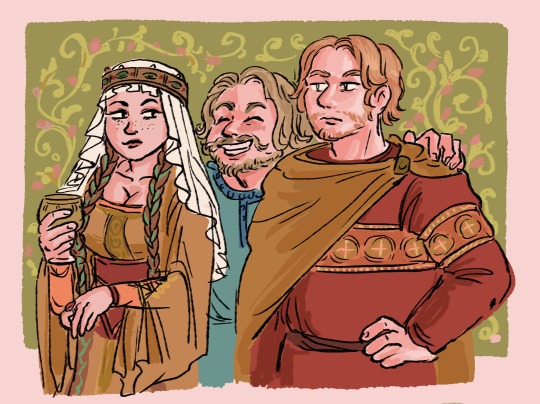

Matilda of Saxony/Bertran de Born/Count Richard
“I wish that Lady loved me, and the Lord of Poitou loved me too!”
#Idk if the quote is real but I like to imagine.#this is in his head btw. He’s not getting laid RIP#Bertran de born#troubadour sandwich#Richard the lionheart#Matilda of Saxony#angevins#12th century#medieval#my art#happy new year!
16 notes
·
View notes
Text
Henry the Young King: Tillie, if you hit me with one more goddamned blue shell-
Matilda of England, Duchess of Saxony: Get fucked, loser.
Richard I of England: HOW AM I STILL GOING THE WRONG WAY WHAT THE FU-
John, driving off the edge of a cliff for the 50th time: WHY CAN'T I TURN-
Eleanor of England, Queen of Castile, just happily playing Animal Crossing New Leaf while Geoffrey and Joan watch: :]
#eleanor doesn't like the chaos of family game night so she'll retreat into nice happy peaceful games#geoffrey just gets tired of everyone after a while#joan refuses to learn how to play
1 note
·
View note
Text
Henry the Lion with his wife Matilda of England, Duchess of Saxony being crowned as the Duke of Saxony
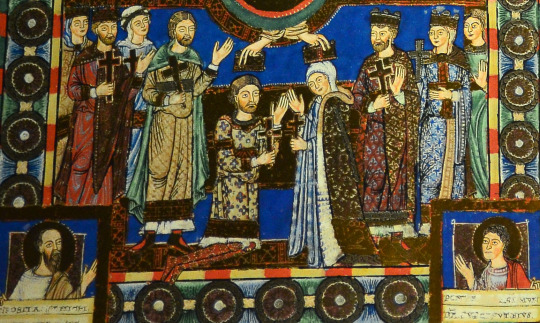
from Evangeliar Heinrichs des Löwen (1188)
0 notes
Photo





the granddaughters of henry ii and eleanor of aquitaine
#historyedit#history#eleanor of aquitaine#isabella of england#joan lady of wales#joan of england#matilda of saxony#matilda of england#eleanor of england#eleanor of castile#berengaria of castile#urraca of castile#blanche of castile#eleanor fair maid of brittany#malafda of castile#12th century#13th century#english history#british history#scottish history#spanish history#welsh history#our edits#by julia#german history#sicilian history#italian history#portuguese history
306 notes
·
View notes
Text

Henry the Lion and Matilda of England
* Gospels of Henry the Lion (1188)
source: AnonymousUnknown author, Public domain, via Wikimedia Commons
#Henry the Lion#Matilda of England#House of Plantagenet#duke#duchess#Saxony#Bavaria#medieval#art#illumination#12th century
42 notes
·
View notes
Photo
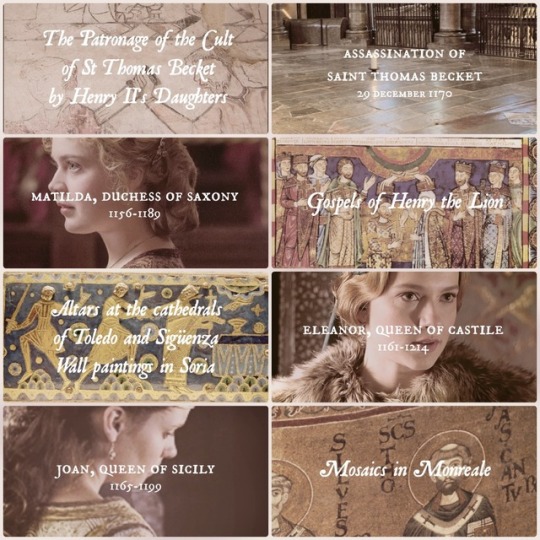
The Patronage of the Cult of St Thomas Becket by Henry II’s Daughters | Matilda of Saxony, Leonor of England, Joan of England
«The Anglo-Castilian connection in this period is also represented by the queen’s efforts to cleanse her father’s memory after the murder of Thomas Becket. Leonor had married Alfonso [VIII of Castile] only a few months before the murder of the archbishop of Canterbury in his own cathedral, events that left Christian Europe in shock. News of his brutal assassination caused immediate reaction all over Europe and must have soon reached the Castilian court and Leonor’s ears. Her father was blamed for the prelate’s murder and the mighty king of the English was brought to his knees through public repentance and expiation. But soon after Becket’s horrid death, Henry II’s expiation turned into veneration and so the martyr of Canterbury – canonised in 1173 – having been a victim of Plantagenet wrath was then becoming an object of Plantagenet piety and devotion.
Kay Brainerd Slocum has studied the spread of the cult in Europe due to the patronage of Henry’s daughters and has suggested that the queen of Castile «departing from the usual practice, wished to establish her own very close connection, and that of her natal family, to the Canterbury martyr». The wonderfully coloured prayerbook of Henry of Saxony and Bavaria, married to Matilda of England, and the stunning mosaics of Monreale in Sicily, commissioned during the queenship of her youngest sister, Joan, bear witness to the agency of Henry II’s daughters in the promotion of Becket’s cult across the continent.
Leonor paid her dues in Castile and her contribution to the cult was manifest and resolute. The queen joined her father’s cry for divine forgiveness in the dedication of altars at the cathedrals of Sigüenza and Toledo and perhaps in the commission of wall paintings at a church in Soria».
Cerda, José Manuel: The Marriage of Alfonso VIII of Castile and Leonor Plantagenet: the first bond between Spain and England in the Middle Ages, in: Aurell, Martin (ed.): Les Stratégies matrimoniales (IXe-XIIIe siècle), Turnhout, Brepols, 2013, pp. 143-153, pp. 146-147.
Or: my favourite sisterly alliance.
#leonor plantagenet#joan of england#joan of sicily#mathilda of saxony#matilda of saxony#henry the lion#alfonso viii#medieval#medieval queens#henry ii#henry ii of england#saint thomas becket#thomas becket#alienor of aquitaine#eleanor of aquitaine#william ii of sicily#alfonso viii of castile#monreale#monreale cathedral#mosaics#illuminations#plantagenets#plantagenet#plantagenet england
173 notes
·
View notes